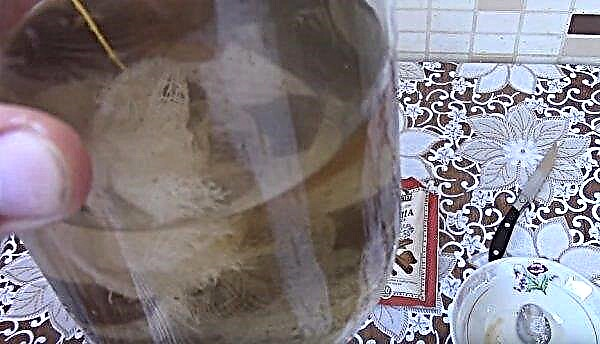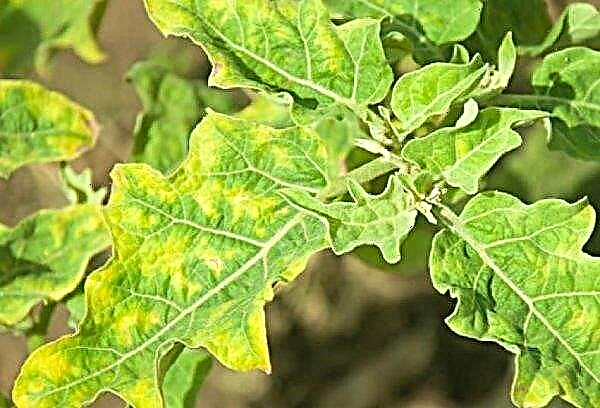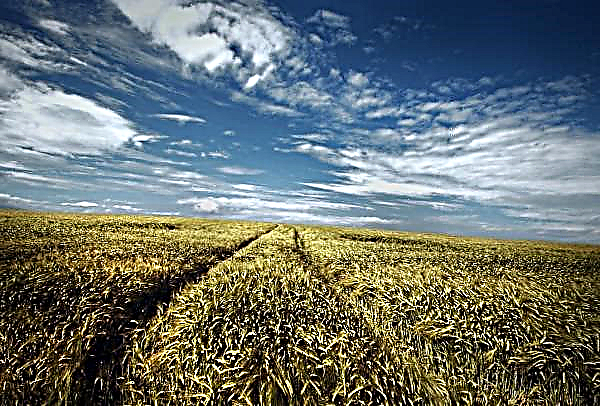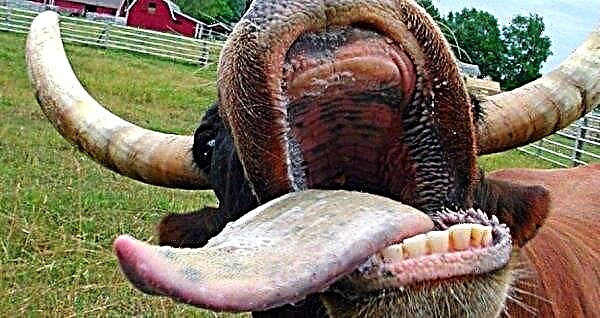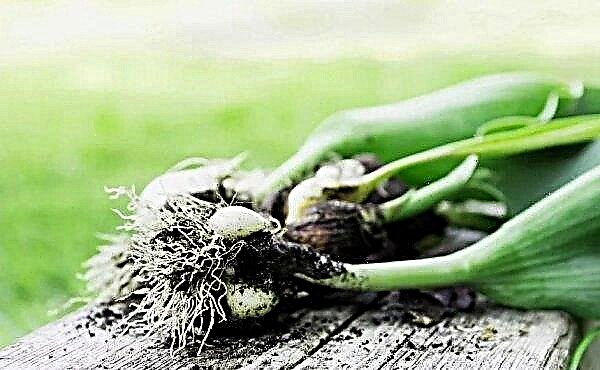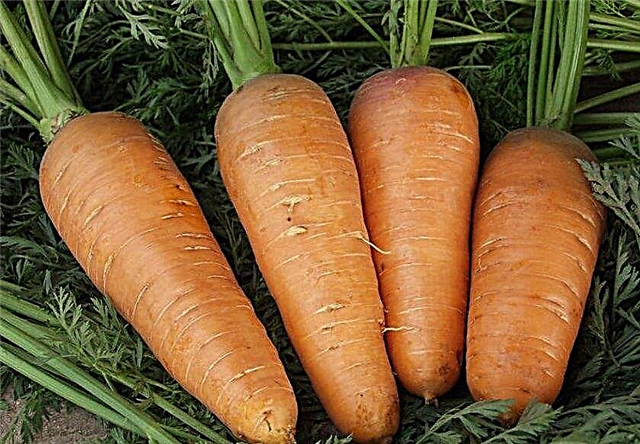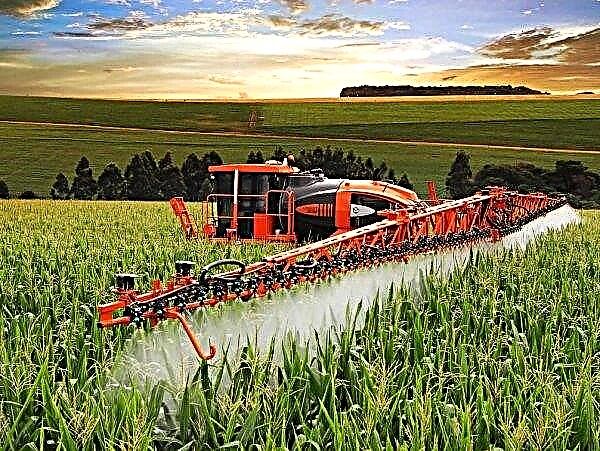Original grapes are known to many gardeners. This plant is able to produce high yields, characterized by excellent production characteristics, as well as taste. However, not everyone decides to grow this variety on their own site, since it requires not only qualified care, but also attention. Next, you will get acquainted with the main features of the “Original” grapes, as well as learn what you need to grow it.
History of Variety Breeding
Original grapes are a selection product and the true pride of Ukrainian plant growers. This variety was bred in 1970 by a group of scientists from the Institute of Viticulture and Winemaking named after Vasily Egorovich Tairov. The hybrid in question was obtained by crossing the Damascus Rose and Dathier de Saint-Valle.
As a result of the long-term work of scientists, the hybrid acquired only the best qualities of the original varieties - it is a highly productive variety of grapes characterized by an unusual shape and color of berries.
Did you know? Until the second half of the 19th century, cultivated grape varieties in Europe could grow and bear fruit for about 150 years. But after the appearance of phylloxera (a pest insect) in 1863, their life expectancy sharply decreased.
Description of grape variety “Original”
"Original" is a table grape of medium-late ripening, suitable for technological processing, as well as fresh consumption. In a temperate climate, fruit ripening occurs in the second half of September, which makes it possible to enjoy the fruits throughout the fall.
Description of berries
The berries are large, juicy, fleshy, with a dense peel, elongated, slightly elongated on the edge and rounded on the sides. The peel is well separated from the pulp. The average weight of the berry reaches 12 g, and its size is 32 × 20 mm.
Their color is diverse, depending on the hybrid, the shade can vary from white to pink and dark blue, almost black. In one berry there are no more than 2-3 seeds.
Bush description
The bush is large and tall. The leaves are large, five-lobed, with a characteristic slight pubescence. During flowering, small bisexual flowers are observed on the plant. During cultivation, the vine fully withstands the mass of the crop, so the bushes do not need a garter.
On one shoot, on average, about 6-7 clusters of berries appear. The number of fruit-bearing branches in the average bush is at least 65% of the total mass, with more than half of the young branches becoming wooden during one growing season.
Cluster characteristics
Large loose clusters of regular conical shape ripen on the bush, slightly pointed at the end. The average mass of one bunch reaches 500–800 g, but under optimal conditions it can increase up to 1000–2000 g. The fruits are practically not suitable for transportation, under average and strong mechanical stress they burst and crumble.
Taste characteristics
The taste of grapes is simple, but rich and harmonious. The sugar content of berries is about 14–20%, while the acidity does not exceed 9 g / l. Tasting evaluation of fruits is 8.8 points.
Productivity
The yield of the plant is high: from one adult bush you can collect up to 100 kg of berries, which is 9–11 tons per hectare. The fruitfulness coefficient of the crop is 1.2–1.7 points.  The harvest of this grape is able to be stored from autumn until the middle of winter. At the same time, the berries adhere perfectly to the stalk and do not crumble over time.
The harvest of this grape is able to be stored from autumn until the middle of winter. At the same time, the berries adhere perfectly to the stalk and do not crumble over time.
Resistance to external factors
The “original” is quite resistant to all kinds of climatic changes. This variety is well adapted to high temperatures, and is also able to withstand frosts to –21 ...– 24 ° С. The plant is resistant to diseases and pests.
This grape has a natural immunity to mildew, powdery mildew, rot, and is almost not affected by phylloxera, spider mites and leafworms.
Important! Original grapes are often quite susceptible to wasps. Insects damage the berries, which reduces the keeping quality and presentability of the crop.
Grape Varieties
Today “Original” grapes are found in 3 main varieties, which differ in color and characteristics of the fruit.
These are the so-called hybrids:
- The black - has berries of a deep dark blue, almost black shade.
- White - its fruits are painted in pale green shades.
- Pink - differs in a crop of pink-green or pale pink.
Black Original
The main distinguishing qualities are presented in the table:

| Characteristic | Description |
| Fruit ripening duration | 135-145 days |
| Cluster weight | 500-800 g |
| The average weight of the berry | 7–9 g |
| Crop Sugar | about 15% |
| Acidity level | 7–9 g / l |
| Frost resistance | up to –24 ° С |
White Original
White has the following characteristics:

| Characteristic | Description |
| Fruit ripening duration | 140-150 days |
| Cluster weight | 500-700 g |
| The average weight of the berry | 6–8 g |
| Crop Sugar | about 15% |
| Acidity level | 7–9 g / l |
| Frost resistance | up to –24 ° С |
Pink Original
The variety is characterized by the following properties:

| Characteristic | Description |
| Fruit ripening duration | 130-145 days |
| Cluster weight | about 1000 g |
| The average weight of the berry | 7–9 g |
| Crop Sugar | about 15–20% |
| Acidity level | 5-6 g / l |
| Frost resistance | up to –26 ° С |
Advantages and disadvantages of the variety
- The main advantages due to which the "Original" has become popular:
- unusual shape of clusters and berries;
- fast bush growth;
- large formations with which you can increase the yield of the plant;
- long shelf life of the crop;
- resistance to rot and other fungal infections.
Did you know? The most ancient grape variety in the world is the Limnio variety. This plant was widely cultivated since antiquity. — more than 3 thousand years ago.
- Not without variety and disadvantages, the main ones are:
- low frost resistance;
- lack of immunity to felt mites;
- predisposition to peeling berries (in case of bad weather during flowering);
- fruits can form on stepsons, which reduces the actual yield of the bush at times;
- unsuitability of bunches for long transportation.
Features of the cultivation of the variety "Original"
[strike] [/ strike] To grow grapes on the site is not difficult - this crop is considered unpretentious. However, in order to achieve rapid vine growth and high productivity, it is imperative to take care of the right place for planting, as well as carry out a number of preparatory measures. Without this, the plant can be sick for a long time and often refuse to root.
Choosing a landing place
Since the described variety loves a warm and mild climate, it is best to plant the “Original” on the south side of the site.  This is one of the main requirements when cultivating a plant, since only on the south side will it receive the maximum amount of light and heat, which are important for proper development and fruiting. In addition, on the south side, young cuttings take root very quickly, which will help them to endure winter frosts painlessly.
This is one of the main requirements when cultivating a plant, since only on the south side will it receive the maximum amount of light and heat, which are important for proper development and fruiting. In addition, on the south side, young cuttings take root very quickly, which will help them to endure winter frosts painlessly.
Important! If the grapes are not planted on the south side, the depth of planting should be increased by 20 cm. This will help preserve the root after wintering, even in case of poor rooting.
Landing time
There are two methods for planting grapes: spring and before winter. In the spring, planting is carried out in mid-April, before young leaves bloom on the vine. In autumn, grapes are rooted in early October.
Today, there are many discussions among gardeners about the appropriateness of a particular method, but the plant is best rooted in the spring. At this time, the most active metabolism is observed, which directly affects the rate of adaptation of the sprout to the natural environment.
In addition, when planting for the winter, grapes must be covered, which further complicates its rooting.
Landing pit preparation
In order for young seedlings to quickly grow, you need to carefully approach not only the choice of planting material, but also the preparation of the site. To do this, you need:
To do this, you need:
- Choose the most flat soil or place on a small hill.
- Dig a hole 80 × 80 cm.
- At the bottom of the pit, lay a 10 cm thick layer of compactor from crushed stone or broken brick. If your site has soil with high moisture capacity (clay, loamy soil, chernozem), you can refuse the procedure.
- Lay a 10 cm layer of fertilized soil at the bottom, and then water the well well.
- As soon as the water is absorbed, 3 kg of organic fertilizers (manure) should be put in the hole, and a mixture of 300 g of wood ash, 250 g of superphosphate and 100 g of potassium nitrate should be poured on top.
- Next, the recess is filled with soil to 1/3 of the initial volume, after which the stalk can be successfully planted in the resulting hole.
Care for a young and mature vine
Proper care of the variety “Original” is one of the main components of high productivity. Particular attention should be paid to watering and top dressing. Young and adult shrubs are watered no more than 3 times per season, but abundantly, soaking the soil to lower horizons. In humid climates and rainy summers you can refuse watering.
A young vine less than 1 year old is not fed, an adult is fertilized 1 time per season, in spring. For this, complex nitrogen solutions with a calculation of 100 g / 10 l of water / 1 bush are used. Once every 3 years, grapes will be fertilized with organic fertilizers (manure) with a calculation of 6-7 kg / m² of plantings.
In the first year of rooting, grapes require a minimum of care. At this stage, it is important to ensure that useless shoots do not form on the plant, so by the autumn only 3-4 of the strongest branches leave on the bush.
It is also important for a young plant and a sufficient amount of oxygen in the soil, so it is well loosened 1-2 times a month. As the seedling grows, you need to tie it to the support, otherwise you will get a bush shape that is excessively difficult to care for. Care for adult bushes is more painstaking, the highest yield of the plant is observed on shoots at the age of 2-3 years, therefore, as the growth grows, the old lignified branches are gradually removed. The procedure is carried out in the middle of spring, before the start of the active vegetation, or in the fall, after harvesting.
Care for adult bushes is more painstaking, the highest yield of the plant is observed on shoots at the age of 2-3 years, therefore, as the growth grows, the old lignified branches are gradually removed. The procedure is carried out in the middle of spring, before the start of the active vegetation, or in the fall, after harvesting.
In addition, a mature vine necessarily requires load rationing, otherwise it can break off under the influence of heavy clusters, which always ends with a loss of yield.
Also, the correct distribution of clusters on the bush helps to achieve the fastest possible ripening of the crop, which is one of the most important factors for a temperate and northern climate. The procedure is carried out 2 times per season, in early autumn and in the middle of summer.

In spring, young, lignified parts and tops are removed - this helps to form a bush that is convenient for maintenance and to avoid wasting plant energy on ineffective shoots. After the ovary has formed on the bush, it is thinned out, evenly distributing the forming fruits.
The number of clusters on one fruit shoot depends on weight, climate, growing background and experience of the gardener. Under optimal conditions, it is recommended to leave no more than 2 clusters on one fruiting shoot. But if the variety is grown in a cold climate, it is recommended to leave no more than 1 bunch, otherwise the crop does not have time to ripen.
Winter preparations
If you grow a crop in a temperate or northern climate, grapes must be prepared for winter. The procedure begins long before the frost, in mid-autumn. Unnecessary, damaged and dry shoots are removed on the grapes, leaving only a viable vine with potentially active buds.
When a clear decrease in the average daily temperature occurs, they shelter the grapes.Important! After the snow falls, it is recommended to additionally cover the grapes with snow, which will significantly improve the thermal insulation properties of the shelter.
For this:
- Lay dry spruce or pine boards along the vineyard.
- Loosely tie the branches of the bush together and lay them on the boards.
- Create around the branches a protective dome made of metal mesh or arcs, and then cover it with polyethylene or a special covering fiber. They can be replaced with straw, hay or sawdust, while this layer should be at least 10-15 cm thick.

Features of the reproduction of grapes
The variety under consideration is capable of propagating both by seeds and parts of the bush. Propagation by seeds in crop production is rarely used. This method quite often leads to degeneration of the variety, which affects not only its yield, but also morphological qualities. Therefore, seeds are germinated only in laboratory conditions, when new varieties are bred.
Vegetatively (parts of the bush) propagate grapes everywhere. This method makes it possible to obtain rooted plants in both spring and summer. Traditionally, spring propagation is considered more preferable, as it makes it possible to root grapes in just a few weeks.

For the procedure, cuttings are used - viable parts of the shoot with a length of about 30–40 cm. Only young shoots with a thickness of about 1 cm are used for harvesting planting material, with at least 2-3 viable eyes. Germination is not difficult and is carried out according to a pattern similar to planting (according to the method described above).
Diseases and methods for their treatment
As mentioned above, the variety is quite resistant to a variety of diseases, however, due to the susceptibility of the culture to infections, even it often gets sick. The most common diseases of grapes are considered to be fungal infections, which lead not only to pathologies of foliage and shoots, but also to deterioration of the quality of the fruits.
The most common diseases of the “Original” grapes and their signs are indicated in the table:
| Disease | Key features |
| Downy mildew | there are yellow spots on the leaves with white inclusions similar to cotton wool |
| Powdery mildew | a gray coating appears on the leaves and berries |
| Alternariosis | light brown spots on foliage |
| Gray rot | light gray coating on all parts of the bush |
| Black rot | brown spots appear on the berries, which soon lead to their withering and suppuration |
| White rot | light white coating on the berries and stalks of bunches |
In the event of the above pathologies appearing on the plant, the sick bush is recommended to be treated with complex fungicides twice, with an interval of 14 days.
Most often, two types of drugs are used for these purposes:
- local exposure - have a superficial effect, without penetrating the plant tissue. The most popular of them is Cineb, a solution of colloidal sulfur and Bordeaux fluid;
- systemic action - penetrate into all tissues and fluids of the plant. The most effective are the solutions of "Ridomil", "Vectra" and "Falcon".
Reviews about the cultivation of grape varieties "Original"
The original is a very good grape variety available for cultivation in rather difficult weather conditions. Beautiful appearance, original color and delicate taste justify its name. It turned out that this winter I had several bushes left uncovered, but nevertheless the original survived and is developing normally. True loss on the vine and buds on these bushes is very noticeable. Yes, it grows smaller and does not ripen in stepsons; in the beginning of summer, mildew is observed. but this does not detract from its merits.
http://www.vinograd777.ru/forum/showpost.php?s=9058878bc3574f771a2b7ce0d4c644cb&p=1376&postcount=2
As for me, the variety is not very bad. With good care, an impressive bunch, a rather large berry of an interesting shape, a very decent taste. And the disadvantages are each grade. And this one, too, with full ripening, the berry is not firmly held on the crest and a little liquid consistency.I planted it under windows from the southwest for shading instead of blinds. Not lost. And the shadow is wonderful (very tall), and grapes are eaten in September from the main clusters, and in October from the stepsons.
Nikola
http://www.sadiba.com.ua/forum/showpost.php?s=a8167fe620ee3dce5c99d0e1c464eb82&p=954204&postcount=7



